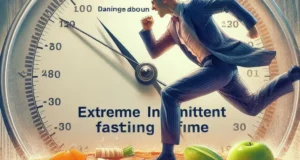Picture this: you’re late for a train, and instead of walking to the station, you hop into a high-speed car and zoom through red lights, dodging traffic just to make it on time.
When people talk about drastic weight loss methods, crash diets often sit front and center. They’re intense, immediate, and unforgiving. Are they worth the ride—or do they leave you broken down on the side of the road?

The Nature of a Crash Diet
Crash diets are typically very low-calorie and often nutritionally imbalanced. They may involve eating less than 800–1,000 calories per day and often eliminate entire food groups—no carbs, no fats, sometimes no solids at all.
Common crash diets include:
- The Cabbage Soup Diet
- The Grapefruit Diet
- Juice-only Cleanses
- Hollywood Detox Plans
These diets are not designed for sustainability. Instead, they are intended for rapid weight loss, usually over 3 to 10 days. They promise inches off your waistline in exchange for strict adherence and sacrifice.
The Visible Results: Fast but Fragile
One of the main reasons people turn to crash diets is because they produce results you can see almost immediately. In just a few days, you may drop 5 to 10 pounds.
But here’s the truth: much of this is water weight, not fat. When you drastically cut calories or carbs, your body uses stored glycogen, which holds water.
This leads to a slimmer face, reduced bloating, and a looser waistband. The mirror reflects progress—and for many, that’s motivating. These quick wins are why crash diets continue to be a popular form of drastic weight loss methods.

The Hidden Costs: A Body Under Stress
But beneath the surface, your body is sounding silent alarms.
Think of a crash diet as slamming on the brakes in a speeding car. You stop suddenly, yes—but the jolt can cause damage. The metabolism begins to slow down. Hormones become disrupted. Energy levels crash. Cravings rise like waves during a storm.
Over time, this leads to:
- Muscle loss, especially if protein is lacking
- Nutrient deficiencies, since vitamins and minerals are often missing
- Fatigue, irritability, and brain fog
- Rebound weight gain once normal eating resumes
In some cases, the body even holds onto fat more tightly after a crash diet, anticipating another “famine” around the corner. That’s why many experts warn against using these drastic weight loss methods for more than a few days.
Psychological Effects: The Rollercoaster Mind
Crash diets not only affect your body, but also your relationship with food. They create a binge-restrict cycle, where deprivation leads to overeating, guilt, and another crash diet.
This on-again, off-again approach can damage long-term motivation, self-image, and trust in one’s ability to eat intuitively.
Is There Ever a Good Time for a Crash Diet?
Surprisingly, the answer is maybe. In some scenarios—such as preparing for a photoshoot, dropping weight for a sporting event, or jumpstarting a healthier plan—a short, well-monitored crash diet might serve as a temporary strategy.
But it must be followed by a balanced eating plan, hydration, and gradual reintroduction of nutrients. Without this transition, the initial crash diet results vanish as quickly as they appeared.
A Flash Fire, Not a Long Burn
Among all drastic weight loss methods, crash diets are the brightest flash in the pan. They offer quick, dramatic results, but often at the expense of long-term progress and well-being.
They are not inherently evil—they are simply tools that must be used wisely, like fire in the hands of a skilled chef or a reckless pyromaniac.
If you’re considering a crash diet, go in with eyes open. Expect rapid results—but also plan for what comes after the crash. Because what truly matters is not just how fast you lose weight—but how well you keep it off.




